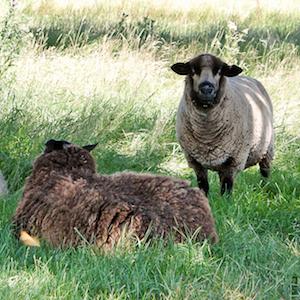It's dangerous being livestock. If you aren't being fattened up to be turned into a Happy Meal, you're wandering the fields, gobbling up plants that appear tasty and innocent but are actually toxic. Some can cause death, while others cause horrifying birth defects, like a mother giving birth to a cyclops. Every year, plant poisonings cost the livestock industry more than $500 million.
A new review article, written by the USDA and published in the Journal of Agricultural and Food Chemistry, discusses some of the most common problematic plants.
Veratrum. If a pregnant ewe (sheep) consumes Veratrum californicum (photo A), the lamb may be born as a cyclops. The steroid-like toxin responsible for this and other deformities is named, appropriately enough, cyclopamine.
Locoweed. Locoweed plants (photo B) aren't poisonous by themselves; instead, they host a fungus that produces a toxin that causes animals to act "crazy" or loco in Spanish. Cornell University describes the (possible) backstory:
One can imagine how this name came to be -- if an otherwise calm animal became aggressive, running around with an odd gait, running into objects with its head held low and finally keeling over dead -- "crazy" is an apt description.
Locoweed can also cause birth defects and reproductive problems.
Larkspur. The group of plants known as larkspur (photo C) cause flaccid muscle paralysis in cattle. (Something similar happens with botulism poisoning: Imagine every muscle in your body going completely limp. Death occurs because you stop breathing.)
Lupine. Lupine (photo D) causes "crooked calf syndrome," which derived its name from cattle being born with twisted spines and other skeletal defects.
Pine needle-induced abortions. Ponderosa pines (photo E) and junipers are beautiful trees, but their needles are toxic. Compounds in these needles act as abortifacients, which trigger abortions in cattle, especially in the third trimester.
Pyrrolizidine alkaloids. These toxic compounds are found in thousands of plants, one of which is Senecio (photo F). Pyrrolizidine alkaloids (PAs) can cause liver failure (see PDF, page 20) and are especially toxic to fetuses and young animals. PAs are a problem for humans, too. Grains, milk, honey, eggs, and herbal products can be contaminated with PA, which is a constant safety concern for the global food supply.
Monofluoroacetate. Monofluoroacetate is a naturally occurring pesticide made by plants to keep herbivores away. It works extremely well. Animals that eat plants like Palicourea marcgravii (photo G) have been known to just drop dead. Sodium fluoroacetate, a synthetic version of the pesticide known commercially as 1080, is used to control animal pests such as rodents.
Toxins are a fact of life. Animals evolved to eat plants, and plants evolved to fight back. The struggle to survive is often a brutal one.
Source: Kevin D. Welch, Stephen T. Lee , Daniel Cook , Dale R. Gardner, and James A. Pfister. "Chemical Analysis of Plants that Poison Livestock: Successes, Challenges, and Opportunities." J. Agric. Food Chem. 66 (13): 3308-3314. Published: 20-Mar-2018. DOI: 10.1021/acs.jafc.8b00337




